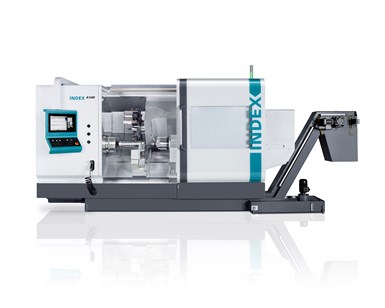Index Corporation Lathes Feature Upgraded Toolholders
The Index B400/B500 and Traub TNA400/TNA500 lathes are equipped with the VDI40 radial turret with 18 toolholders.
Index Corporation’s CNC universal lathes, which includes models Index B400/B500 and Traub TNA400/TNA500, have been upgraded to feature 18 tool locations.
The four Index universal lathes share many common features: the Index B400/B500 and Traub TNA400/TNA500 all use the same machine bed, cover and inner cover, and have identical slide systems. Yet, there are a few differences between them, including the control technology they use. While the Index B400 and B500 feature Siemens’ Sinumerik 840D sl, the Traub TNA400 and TNA500 are equipped with the Traub TX8i-s V8 controller based on Mitsubishi controls.
Another difference resides in the working spindles of the various machine sizes. While the models of the 400 series are equipped with an A8 main spindle (82-mm spindle clearance, 315-mm chuck diameter) and an A6 counter spindle (65-mm spindle clearance, 175-mm chuck diameter), the models of the 500 series use an A11 main spindle (102-mm spindle clearance, 400-mm chuck diameter) and an A8 counter spindle (82-mm spindle clearance, 250-mm chuck diameter).
The maximum turning length is 750 mm for the Index B400 and Traub TNA400. Index now offers a long version for each of the two large universal lathes B500 and TNA500, which enables a turning length of 1,200 mm. The remaining performance data remains unchanged, while the length of the machines has grown from 3,595 mm to 4,271 mm and their weight has also increased.
Changes have also been made to the turrets: in the counter-spindle versions, all universal lathes — long versions included — are equipped with the VDI40 radial turret with 18 toolholders. Customers can opt for a VDI40 disk-type turret with up to 12 toolholders. Its main advantages come to bear when using large solid drills or boring bars, since the design of the disk-type turret implies that forces are transmitted vertically into the turret.
RELATED CONTENT
-
Compact Headstock Lathe With High Power Density
This sliding headstock automatic lathe offers simultaneous machining with up to 3 tools — each tool with a variable feed rate.
-
Multispindle Automatic Lathe With Full System Concept
PMTS 2023: Tajmac’s Penta TMZ 518 is a five-spindle automatic lathe that features an island concept which offers the machine as a package.
-
Tsugami America Lathe Enables Simultaneous Machining
Eastec 2023: The BW129Z Swiss-type lathe uses a three-path control system and dual independent-gang slides to reduce cycle time and produce complex parts quickly.




